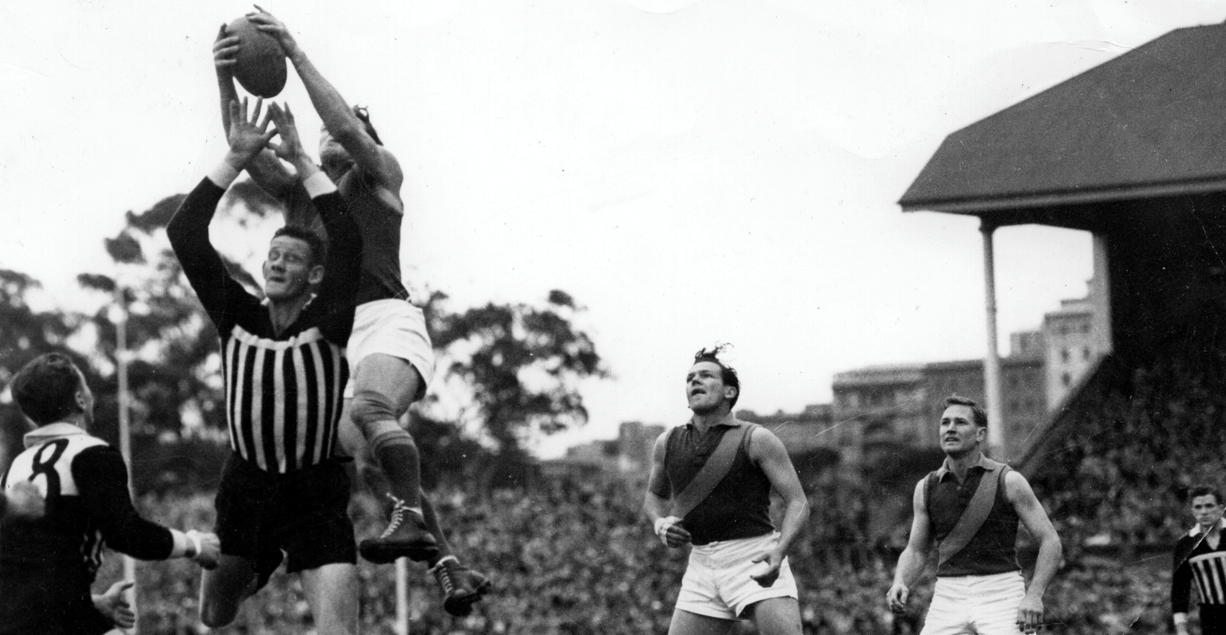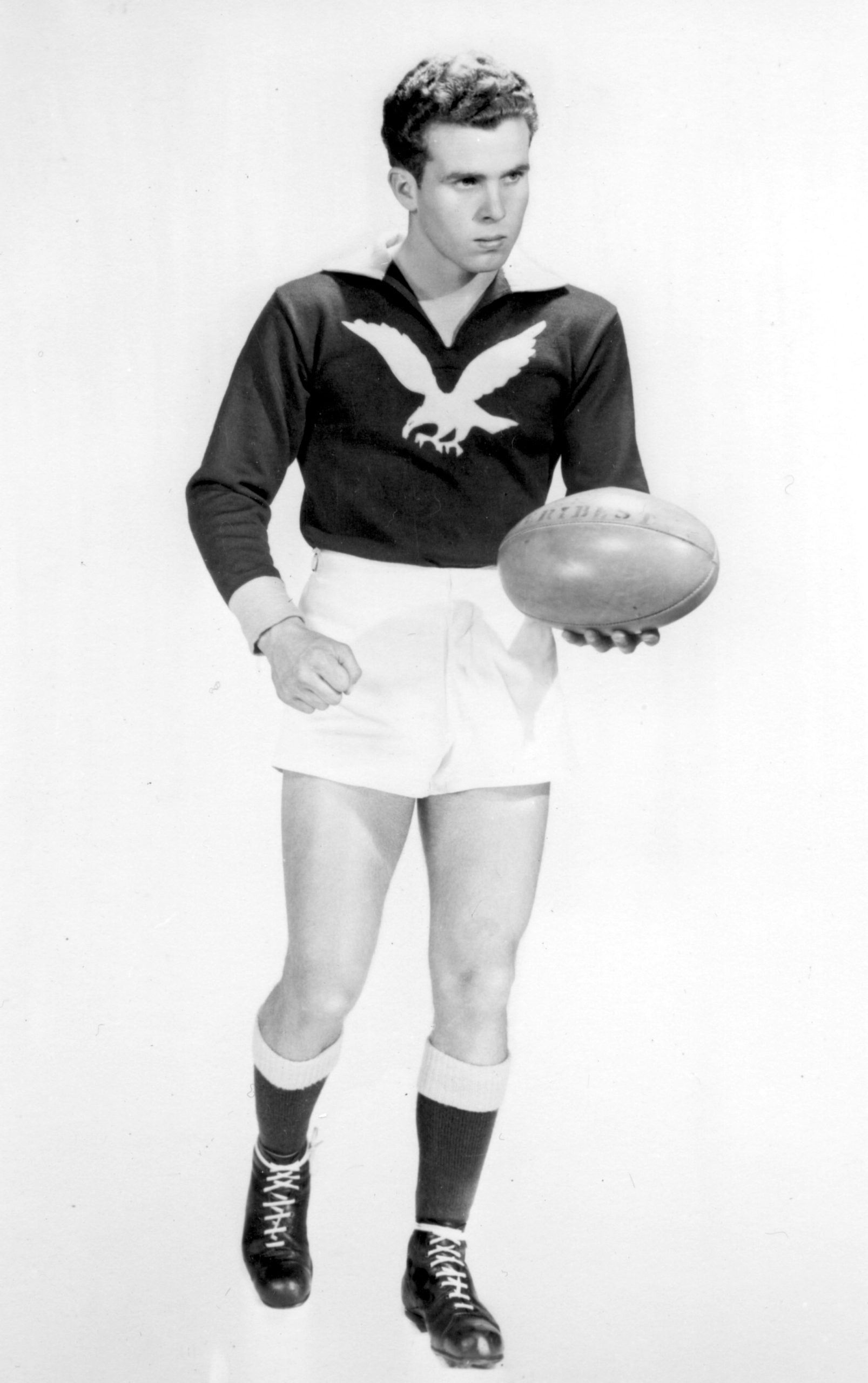
Stuff of Legends
West Torrens star Jim Coverlid soars for a big mark in the 1953 grand final thriller against Port Adelaide at Adelaide Oval.
By STEVE BARRETT
If Lindsay Head possessed future-predicting powers to match the magic he showcased on the football field, he and his West Torrens team-mates might have taken the opportunity, 70 years ago, to celebrate a bit harder.
In his first full SANFL season, 17-year-old Head experienced the first of what he believed would be many premierships when Torrens snatched a thrilling seven-point win over Port Adelaide in the 1953 grand final. Only there wouldn’t be ‘many’ more opportunities … in fact there wouldn’t be any.
“I was lucky to come into a side that was ready to win a premiership,” recalled Head, a star from the moment he booted seven goals in his second league match. “I started halfway through the year before in 1952, then we won the premiership in my first full season and I thought ‘how easy is this going to be?’. I never played in another grand final.”
Head, an inaugural inductee into the Australian and SA Football Halls of Fame, collected a staggering eight club best-and-fairest awards and three Magarey Medals, is Torrens’ all-time leader in games (327) and goals (525) and served his beloved Eagles with distinction as captain, coach, captain-coach and president. He became the first player to reach 300 SANFL games and made a whopping 37 senior appearances in the State jumper, first representing SA in 1947 at a State schoolboys carnival in Perth as an 11-year-old.
For today’s football fans, think of a less brawny, tattoo-free version of Richmond superstar Dustin Martin … both goalkicking midfielders. Flashy, immaculate ball users. Untacklable in their pomp.
“Every time my wife (Jill) sees Dusty play, she says ‘gee, that’s how you used to play’,” said Head, who turned 88 last Saturday. “I was one of the first players to kick the checkside for goal and I used to kick it around the ground as well. Dusty kicks it on the outside of his foot to a leading team-mate, which I started 60 years ago. They called me the Artful Dodger because I had a sixth sense where everyone was. Dusty plays a bit like that.”
But, unlike Martin, a triple AFL premiership winner, ultimate club success eluded Head.
With the exception of that one day in 1953.

West Torrens young gun Lindsay Head, in the universally-loved Eagles guernsey, went on to win three Magarey Medals.
Coached by Joe Kinlough – described by Head as “a nice guy and a gentleman, who I knew of because he played for Torrens with my dad” – the Eagles had to climb out of a massive hole in the second semi-final to advance to the decider. Torrens trailed minor premier Port Adelaide 6.6 to nil in the second quarter before slamming on 14 of the last 15 goals to trample the Magpies by 46 points.
Port bounced back to thrash Glenelg in the preliminary final, setting up a rematch in the decider. Legendary Bob Hank, described by Head as “my idol when I was a kid … a brilliant player and a gentleman”, was coming off a severe dose of influenza which he contracted before the semi-final. The bug spread to Head, who dragged himself out of his sick bed for the grand final.
“I always found if there was something wrong with me, I played better anyway,” he said. “The flu didn’t worry me too much.”
Port captain-coach Fos Williams – a cousin of Head – won the toss and the Magpies kicked to the river end, aided by a stiff north-easterly. Head’s flying goal deep into the term evened the scores before Neville Hayes’ snapped six-pointer gave Port a six-point quarter-time lead.
The Eagles edged ahead by a point at half-time despite losing the advantage of the breeze as the wind veered westward in the second stanza. Heavy rain fell at half-time and the showers persisted in a torrid third quarter, at the end of which the Magpies were back in front by a straight kick. They started the fourth term with a couple of behinds to lead by eight points before Bob Hank’s long punt into the forward area ended with Head goaling on the run to trim the gap to two points.
A hurried snap from ruckman Don Prior and a boundary punt from full forward John Willis registered behinds and tied the scores before Head uncharacteristically missed a sitter on the run.
“From that kick-out it went that quickly down Port’s end, I still remember the feeling I had – an empty feeling, a feeling of panic,” Head reflected. “I thought I’d cost us the game because it looked like they were going to kick a goal.”
But the Magpies messed up. With two minutes remaining, Hayes’ attempted handpass to Ron Leaver was intercepted by Torrens half-back Frank Graham, whose rebound down the grandstand wing was marked by team-mate Errol Lodge.
Lodge’s kick was marked by centre half-forward Doug Cockshell before the ball finished in the hands of Ray Hank, whose tired kick for goal floated across the line.
“Chicken thought handball was a Baxian Bandit because Fos wouldn’t let them handball,” Head said. “Frank intercepted Chicken’s handball, we got it over to Ray and he kicked the goal. My miss put us in front, then with Ray’s goal, that’s where the seven points (margin) came from.”
That night, best-on-ground Mick Clingly was in bed by 10-to-six, while flu-afflicted Head also had an early one. “You didn’t celebrate in those days like you do today,” said Head, one of two surviving 1953 premiership players, along with full back Alf Roberts, who also played in the 1945 flag. They might have if they knew Torrens would win only one more final – against Norwood in the 1954 first semi-final – as a standalone entity.
West Torrens champion Lindsay Head“I always found if there was something wrong with me, I played better anyway. The flu didn’t worry me too much.”
For Head, 1963 gnaws at him most. Coached by the great Dick Reynolds, a Legend of the Australian Football Hall of Fame and named Essendon’s captain and coach of the century, Torrens claimed its first minor premiership since 1924, boasting the most talented team in SA, but exited the finals in straight sets.
“The ’63 side was the best side Torrens ever put on the ground,” Head said. “We had Neil Hawke, Bob Shearman, Fred Bills, Geoff Kingston … but we bombed out in the finals. We had some blokes out (for the losing preliminary final), who would have been ready for the grand final.”
Head could have won more flags had he caved in to the overtures of powerhouse SANFL rivals. But he was forever loyal to the blue-and-gold, having grown up “a couple of drop kicks from Thebby Oval” while attending Thebarton Primary and Thebarton Tech. He is, however, capable of casting an objective lens over the Eagles.
“I reckon the Torrens jumper with the gold eagle (introduced after 1954) was the best jumper that was ever invented but they let coaches come into the club and change the jumper and other things, which didn’t sit well with me,” he lamented.
Head stomached rather than welcomed the 1990 amalgamation with Woodville but bemoaned the weakening of the Eagles following their near-neighbour and future partner’s league arrival in ’64.
“Finance said we had to do something like that (merge) but the big thing was when Centrals and Woodville came into the competition,” Head said. “Most of our development area was in Woodville … a lot of those Woodville players in the 1960s, ’70s and ’80s would have (otherwise) been Eagles players. The league gave Torrens the Tea Tree Gully zone, which was vacant land, then where there was development out there, they took it off us and gave it to Norwood. We didn’t get a good deal.”
The modern-day Woodville-West Torrens Eagles have enjoyed markedly more success, winning four flags. “I went to a couple of them and it was good to see but it wasn’t the old blue-and-gold, unfortunately,” said Head, who still occasionally makes the long trek from his Port Elliot home to attend functions and games at Oval Avenue.
“Anyway, that’s what happened and we couldn’t do anything about it. Same as ’53 – many of us thought there would be other premierships but there weren’t. But, other than that, everything’s going good.”
Related News
-
 Pocket Profile
Pocket Profile2025 Hostplus SANFLW Pocket Profile – Woodville-West Torrens
Hostplus -
 Pocket Profile
Pocket Profile2025 Hostplus Pocket Profile – Woodville-West Torrens
Hostplus -
 History
HistoryIn the Spotlight – Footy Park lights up in 1984
-
 History
History70 Years in SA Footy – John Halbert
-
 History
HistoryInto another zone – 1984 Preliminary Final
-
 History
HistorySuper SANFL Semi-Finals
-
 History
HistoryJohn Roberts’ Sweet 16
-
 History
HistoryPayne’s high five








